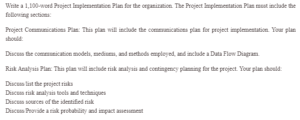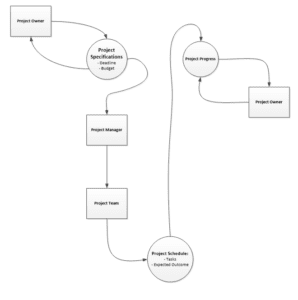Project Implementation Plan
Project Communications Plan
Communication models, mediums, and methods that will be employed, and data flow diagram
The project team will focus on effective communication to ensure all team members achieve common goals and complete the project. The transactional communication model will be applied. This model treats communication as a transaction because it entails cooperation between the sender and receiver to co-create the communication process, the effectiveness of the interaction, and the desired outcome. The model acknowledges that messages influence the subsequent messages or responses in a communication interaction, thus demonstrating that messages are interconnected. This model is appropriate because it creates a strong foundation for communication throughout the project by viewing people as dynamic communicators instead of only senders and receivers. It promotes an overlap in the fields of experience to create shared meaning and interdependence of messages. The communication process will include sharing information from the project owner to the project manager and later to the project team, as shown below. Do you need urgent assignment help ? Get in touch with us at eminencepapers.com. We endeavor to provide you with excellent service.
Data Flow Diagram
The information will include project specifications such as project deadline and budget. The project manager will then give the project owner feedback on whether the project team can meet the deadline and whether the budget is realistic for the project. The project manager may recommend any adjustments that the project owner should consider. The transaction between the project manager and project owner will end when the project owner accepts the project owner’s recommendations or ass the project owner to work with the initial specifications. The communication process will then move to communication between the project manager and the project team. The project team will be informed about the tasks to be completed and the expected project outcome. The project team will then communicate the project progress to the project owner. The project owner will then give feedback on whether the project’s progress is good and provide recommendations on areas of improvement.
The project team will embrace an interactive communication method that allows interaction between team members because the individual on the receiving end is expected to respond. The team will meet regularly to exchange ideas and review project progress face-to-face. Meeting face-to-face will facilitate effective communication throughout the project because the project team can analyze the information on the progress and brainstorm to exchange ideas and resolve problems that could affect project success. The project team will also communicate through emails to create a lasting trail. The emails will include charts outlining the project’s progress.
Risk Analysis Plan
Project risks
One of the risks that the project team may face is delays. Delays are common in construction projects because contracts between the project owner and the project team include schedules and timelines that rarely consider all the variables in the project. Delays may also arise from change orders from project owners, poor project management, and poor scheduling (Larson et al., 2013). The second risk is design risk. This risk arises due to errors in designing structures, the design taking longer than expected, and the failure to follow the project owner’s requirements. The third risk is the shortage of labor. Finding qualified workers in the construction sector is often challenging because most talented individuals already work on other construction projects. Contractors are thus forced to hire workers based on the project’s complexity and scope. Labor shortage may also result in delays, especially if there is a high worker turnover. The fourth risk is health and safety hazards. Construction sites expose workers to various health and safety hazards, including falls and inhaling dust. Accidents may also be fatal, especially when workers fall or are harmed by construction equipment such as concrete mixers and cranes.
Risk analysis tools and techniques
The project team will use decision tree analysis to create a decision process and evaluate outcomes from uncertain incidents. According to Marugán & García Márquez (2017), a decision tree includes the possibility of returns associated with decisions and expected returns’ estimation. The team will also use portfolio management to compare project activities and investment returns. The team will also use portfolio management to characterize risk based on high-risk, low return, or low-risk and high return, ensuring that decisions are made based on the company’s strategy and the highest portfolio value. The team will use the multiple criteria decision-making technique to make decisions. The method considers various project attributes, including a decision’s positive and negative factors. The project team will also analyze risk through root cause analysis. Wysocki (2011) argues that this technique is used to identify fundamental troubles in the project and the source of the dangers to eliminate them effectively. A risk register will be used to identify and describe the stakes in the project to explain the potential impact on the project and the most effective planned responses to eliminate the threat. The stakes will be prioritized using the probability and impact matrix, which combines individual risks’ impact and probability scores and then ranks them based on severity. The relevance of information gathered about risk will be determined using the risk data quality assessment technique. This technique enables project managers to assess the reliability, accuracy, integrity, and quality of data on risks in a project.
Sources of the identified risk
The significant sources of design risk are design omission and errors. In most construction projects, project owners specify the design they want. Failure to meet the project owner’s design specifications may create design risks and force the project team to repeat the project. The primary source of delays is the unavailability of resources. In most instances, resources required to complete a project may be unavailable due to mismanagement of the resources by the project manager or the project team. Project delays may also arise from poor communication between project stakeholders, resulting in unexpected changes that were not considered when creating the project’s schedule. Unforeseen changes in the project’s environment, such as natural disasters, may also result in project delays. The leading cause of the labor shortage is the high demand for qualified workers in the construction industry. Therefore, available workers may ask for higher wages than the project owner can pay, thus creating a shortage of workers. Health and safety standards risks arise from the nature of the construction sites, which includes climbing high structures.
Risk probability and impact assessment
| Risk event | Probability | Impact rating |
| Delays | High | 10 |
| Design risk | Low | 5 |
| Shortage of labor | High | 10 |
| Health and safety hazards | High | 10 |
Based on the data in the table above, it is evident that the probability of delays is high, and the impact rating is also high. This indicates that the chances of experiencing project delays are high and could significantly impact the project due to long-term problems such as failure to meet stakeholders’ deadlines and using more resources than what had been set aside. Shortage of labor and health and safety standards are also highly likely to occur. Their impact on the project is also high because they affect the workforce, reducing the number of individuals completing the activities in the project. However, the chances of having design risks are low, and the impact on the project is moderate. The project can be completed successfully once the design is improved and made based on stakeholders’ specifications.
References
Larson, E. W., Honig, B., Gray, C. F., Baccarini, D., & Dantin, U. (2013). Project management: The managerial process.
Marugán, A. P., & García Márquez, F. P. (2017). Logical decision tree analysis. Decision-Making Management, 11-25. https://doi.org/10.1016/b978-0-12-811540-4.00002-8
Wysocki, R. K. (2011). Effective project management: Traditional, Agile, extreme. John Wiley & Sons.
ORDER A PLAGIARISM-FREE PAPER HERE
We’ll write everything from scratch
Question
Write a 1,100-word Project Implementation Plan for the organization. The Project Implementation Plan must include the following sections:

Project Implementation Plan
Project Communications Plan: This plan will include the communications plan for project implementation. Your plan should:
Discuss the communication models, mediums, and methods employed, and include a Data Flow Diagram.
Risk Analysis Plan: This plan will include risk analysis and contingency planning for the project. Your plan should:
Discuss/list the project risks
Discuss risk analysis tools and techniques
Discuss sources of the identified risk
Discuss/Provide a risk probability and impact assessment


